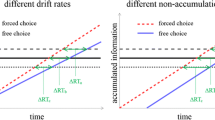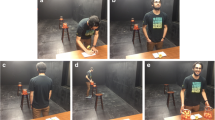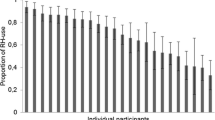Abstract
Free choice tasks are tasks in which two or more equally valid response options per stimulus exist from which participants can choose. In investigations of the putative difference between self-generated and externally triggered actions, they are often contrasted with forced choice tasks, in which only one response option is considered correct. Usually, responses in free choice tasks are slower when compared with forced choice task responses, which may point to a qualitative difference in response selection. It was, however, also suggested that free choice tasks are in fact random generation tasks. Here, we tested the prediction that in this case, randomness of the free choice responses depends on working memory (WM) load. In Experiment 1, participants were provided with varying levels of external WM support in the form of displayed previous choices. In Experiment 2, WM load was induced via a concurrent n-back task. The data generally confirm the prediction: in Experiment 1, WM support improved both randomness and speed of responses. In Experiment 2, randomness decreased and responses slowed down with increasing WM load. These results suggest that free choice tasks have much in common with random generation tasks.






Similar content being viewed by others
Notes
For example, in the thought experiment of Buridan’s ass, a hungry donkey has to choose between two piles of hay, resulting in the donkey’s death of hunger because there is no criterion by which to choose a pile (see also Rescher 2005 for more information).
Indeed, the type of instruction used in free choice contexts bears similarities to a common mathematical definition of randomness derived from Kolmogorov complexity (Martin-Löf 1966). (Over-)Simplified, according to this definition, if a string of information can be described in a more concise manner than if it were simply written out, it is not random. For example, the number 4,294,967,296 can be described much shorter as 2^32. Thus, the number would not be seen as very random.
Another experiment was performed in which the same type of WM support was given except the previous 0, 1, 2, and 3 choices were displayed and a block in which three symbols unrelated to the task were shown instead of previous choices. As the results were largely compatible with the other results, the experiment is not reported here.
In fact, LUD was different from zero in most of the conditions of our experiments.
References
Azouvi P, Jokic C, Der Linden MV et al (1996) Working memory and supervisory control after severe closed-head injury. A study of dual task performance and random generation. J Clin Exp Neuropsychol 18:317–337. https://doi.org/10.1080/01688639608408990
Baddeley AD (1962). Some factors influencing the generation of random letter sequences. Med Res Council Appl Psychol Unit Rep. 422/62
Baddeley AD (1966) The capacity for generating information by randomization. Q J Exp Psychol 18:119–129. https://doi.org/10.1080/14640746608400019
Bausenhart KM, Rolke B, Seibold VC, Ulrich R (2010) Temporal preparation influences the dynamics of information processing: evidence for early onset of information accumulation. Vis Res 50:1025–1034. https://doi.org/10.1016/j.visres.2010.03.011
Berlyne DE (1957) Conflict and choice time. Br J Psychol 48:106–118. https://doi.org/10.1111/j.2044-8295.1957.tb00606.x
Bermeitinger C, Hackländer RP (2018) Response priming with motion primes: negative compatibility or congruency effects, even in free-choice trials. Cogn Process. https://doi.org/10.1007/s10339-018-0858-5
Brass M, Haggard P (2008) The what, when, whether model of intentional action. Neurosci 14:319–325. https://doi.org/10.1177/1073858408317417
Cooper RP, Karolina W, Davelaar EJ (2012) Differential contributions of set-shifting and monitoring to dual-task interference. Q J Exp Psychol 63: 587–612
Dror IE, Basola B, Busemeyer JR (1999) Decision making under time pressure: An independent test of sequential sampling models. Mem Cognit 27:713–725. https://doi.org/10.3758/BF03211564
Ebert JP, Wegner DM (2011) Mistaking randomness for free will. Conscious Cogn 20:965–971. https://doi.org/10.1016/j.concog.2010.12.012
Elsner B, Hommel B (2001) Effect anticipation and action control. J Exp Psychol Hum Percept Perform 27:229–240. https://doi.org/10.1037/0096-1523.27.1.229
Frith C (2013) The psychology of volition. Exp Brain Res 229:289–299. https://doi.org/10.1007/s00221-013-3407-6
Gaschler R, Nattkemper D (2012) Instructed task demands and utilization of action effect anticipation. Front Psychol 3:. https://doi.org/10.3389/fpsyg.2012.00578
Gozli DG, Huffman G, Pratt J (2016) Acting and anticipating: Impact of outcome-compatible distractor depends on response selection efficiency. J Exp Psychol Hum Percept Perform 42:1601–1614. https://doi.org/10.1037/xhp0000238
Grice GR (1968) Stimulus intensity and response evocation. Psychol Rev 75:359–373
Hadland KA, Rushworth MFS, Passingham RE et al (2001) Interference with performance of a response selection task that has no working memory component: an rTMS comparison of the dorsolateral prefrontal and medial frontal cortex. J Cogn Neurosci 13:1097–1108. https://doi.org/10.1162/089892901753294392
Herwig A, Waszak F (2009) Short article: intention and attention in ideomotor learning. Q J Exp Psychol 62:219–227. https://doi.org/10.1080/17470210802373290
Herwig A, Waszak F (2012) Action-effect bindings and ideomotor learning in intention- and stimulus-based actions. Front Psychol 3. https://doi.org/10.3389/fpsyg.2012.00444
Herwig A, Prinz W, Waszak F (2007) Two modes of sensorimotor integration in intention-based and stimulus-based actions. Q J Exp Psychol 60:1540–1554. https://doi.org/10.1080/17470210601119134
Heuer H, Kohlisch O, Klein W (2005) The effects of total sleep deprivation on the generation of random sequences of key-presses, numbers and nouns. Q J Exp Psychol Sect A 58:275–307. https://doi.org/10.1080/02724980343000855
Heuer H, Janczyk M, Kunde W (2010) Random noun generation in younger and older adults. Q J Exp Psychol 63:465–478. https://doi.org/10.1080/17470210902974138
Huffman G, Gozli DG, Hommel B, Pratt J (2018) Response preparation, response selection difficulty, and response-outcome learning. Psychol Res 1–11. https://doi.org/10.1007/s00426-018-0989-4
Jahanshahi M, Dirnberger G, Fuller R, Frith CD (2000) The role of the dorsolateral prefrontal cortex in random number generation: a study with positron emission tomography. NeuroImage 12:713–725. https://doi.org/10.1006/nimg.2000.0647
Janczyk M, Lerche V (2018) A diffusion model analysis of the response-effect compatibility effect. J Exp Psychol Gen. https://doi.org/10.1037/xge0000430
Janczyk M, Pfister R, Kunde W (2012a) On the persistence of tool-based compatibility effects. Z Für Psychol 220:16–22. https://doi.org/10.1027/2151-2604/a000086
Janczyk M, Pfister R, Crognale MA, Kunde W (2012b) Effective rotations: Action effects determine the interplay of mental and manual rotations. J Exp Psychol Gen 141:489–501. https://doi.org/10.1037/a0026997
Janczyk M, Pfister R, Hommel B, Kunde W (2014) Who is talking in backward crosstalk? Disentangling response- from goal-conflict in dual-task performance. Cognition 132:30–43. https://doi.org/10.1016/j.cognition.2014.03.001
Janczyk M, Nolden S, Jolicoeur P (2015a) No differences in dual-task costs between forced- and free-choice tasks. Psychol Res 79:463–477. https://doi.org/10.1007/s00426-014-0580-6
Janczyk M, Dambacher M, Bieleke M, Gollwitzer PM (2015b) The benefit of no choice: goal-directed plans enhance perceptual processing. Psychol Res 79:206–220. https://doi.org/10.1007/s00426-014-0549-5
Janczyk M, Durst M, Ulrich R (2017) Action selection by temporally distal goal states. Psychon Bull Rev 24:467–473. https://doi.org/10.3758/s13423-016-1096-4
Jenkins IH, Jahanshahi M, Jueptner M et al (2000) Self-initiated versus externally triggered movements. II. The effect of movement predictability on regional cerebral blood flow. Brain J Neurol 123:1216–1228
Keller PE, Wascher E, Prinz W et al (2006) Differences between intention-based and stimulus-based actions. J Psychophysiol 20:9–20. https://doi.org/10.1027/0269-8803.20.1.9
Kirchner WK (1958) Age differences in short-term retention of rapidly changing information. J Exp Psychol 55:352–358. https://doi.org/10.1037/h0043688
Koch I, Kunde W (2002) Verbal response-effect compatibility. Mem Cogn 30:1297–1303. https://doi.org/10.3758/BF03213411
Kühn S, Elsner B, Prinz W, Brass M (2009) Busy doing nothing: Evidence for nonaction-effect binding. Psychon Bull Rev 16:542–549. https://doi.org/10.3758/PBR.16.3.542
Kunde W (2001) Response-effect compatibility in manual choice reaction tasks. J Exp Psychol Hum Percept Perform 27:387–394. https://doi.org/10.1037/0096-1523.27.2.387
Kunde W, Pfister R, Janczyk M (2012) The locus of tool-transformation costs. J Exp Psychol Hum Percept Perform 38:703–714. https://doi.org/10.1037/a0026315
Linser K, Goschke T (2007) Unconscious modulation of the conscious experience of voluntary control. Cognition 104:459–475. https://doi.org/10.1016/j.cognition.2006.07.009
Loftus GR, Masson ME (1994) Using confidence intervals in within-subject designs. Psychon Bull Rev 1:476–490. https://doi.org/10.3758/BF03210951
Martin-Löf P (1966) The definition of random sequences. Inf Control 9:602–619. https://doi.org/10.1016/S0019-9958(66)80018-9
Miyake A, Friedman NP, Emerson MJ et al (2000) The unity and diversity of executive functions and their contributions to complex “frontal lobe” tasks: a latent variable analysis. Cognit Psychol 41:49–100. https://doi.org/10.1006/cogp.1999.0734
Naefgen C, Dambacher M, Janczyk M (2017) Why free choices take longer than forced choices: evidence from response threshold manipulations. Psychol Res 1–14. https://doi.org/10.1007/s00426-017-0887-1
Passingham RE, Bengtsson SL, Lau HC (2010) Medial frontal cortex: from self-generated action to reflection on one’s own performance. Trends Cogn Sci 14:16–21. https://doi.org/10.1016/j.tics.2009.11.001
Pfister R, Kunde W (2013) Dissecting the response in response–effect compatibility. Exp Brain Res 224:647–655. https://doi.org/10.1007/s00221-012-3343-x
Pfister R, Kiesel A, Melcher T (2010) Adaptive control of ideomotor effect anticipations. Acta Psychol (Amst) 135:316–322. https://doi.org/10.1016/j.actpsy.2010.08.006
Pfister R, Kiesel A, Hoffmann J (2011) Learning at any rate: action–effect learning for stimulus-based actions. Psychol Res 75:61–65. https://doi.org/10.1007/s00426-010-0288-1
Rescher N (2005) Cosmos and Logos: Studies in Greek Philosophy. Ontos Verlag
Schüür F, Haggard P (2011) What are self-generated actions? Conscious Cogn 20:1697–1704. https://doi.org/10.1016/j.concog.2011.09.006
Towse JN, Neil D (1998) Analyzing human random generation behavior: a review of methods used and a computer program for describing performance. Behav Res Methods Instrum Comput 30:583–591. https://doi.org/10.3758/BF03209475
Waszak F, Wascher E, Keller P et al (2005) Intention-based and stimulus-based mechanisms in action selection. Exp Brain Res 162:346–356. https://doi.org/10.1007/s00221-004-2183-8
Wirth R, Janczyk M, Kunde W (2018) Effect monitoring in dual-task performance. J Exp Psychol Learn Mem Cogn 44:553–571. https://doi.org/10.1037/xlm0000474
Wolfensteller U, Ruge H (2011) On the timescale of stimulus-based action–effect learning. Q J Exp Psychol 64:1273–1289. https://doi.org/10.1080/17470218.2010.546417
Acknowledgements
This research was supported by the Deutsche Forschungsgemeinschaft (DFG; German Research Foundation), grant JA 2307/1–2 awarded to Markus Janczyk. Work of MJ is further supported by the Institutional Strategy of the University of Tübingen (DFG ZUK 63). We thank Davood Gozli for helpful comments on a previous version of this manuscript. In addition, Cosima Schneider and Moritz Durst provided valuable feedback that improved this manuscript.
Author information
Authors and Affiliations
Corresponding author
Ethics declarations
Conflict of interest
The authors declare that they have no conflict of interest.
Ethical approval
All procedures performed in studies involving human participants were in accordance with the ethical standards of the institutional and/or national research committee and with the 1964 Helsinki declaration and its later amendments or comparable ethical standards.
Appendix
Appendix
For completeness, we report the Helmert contrasts separately for each window size in this “Appendix” section.
Experiment 1
The descriptive results of the following analyses are summarized in Table 4.
Contrast 1:
-
Window Size 2: t(29) = 4.44, p < .001
-
Window Size 4: t(29) = 3.48, p = .002
-
Window Size 6: t(29) = 3.11, p = .004
-
Window Size 8: t(29) = 2.82, p = .009
Contrast 2:
-
Window Size 2: t(29) = 1.26, p = .217
-
Window Size 4: t(29) = 0.96, p = .344
-
Window Size 6: t(29) = 0.00, p = .997
-
Window Size 8: t(29) = 0.04, p = .963
Experiment 2
The descriptive results of the following analyses are summarized in Table 5.
Contrast 1:
-
Window Size 2: t(31) = 1.99, p = .056
-
Window Size 4: t(31) = 3.35, p = .002
-
Window Size 6: t(31) = 3.77, p = .001
-
Window Size 8: t(31) = 4.23, p < .001
Contrast 2:
-
Window Size 2: t(31) = 2.18, p = .017
-
Window Size 4: t(31) = 2.88, p = .007
-
Window Size 6: t(31) = 3.51, p = .001
-
Window Size 8: t(31) = 3.85, p = .001
Contrast 3:
-
Window Size 2: t(31) = 3.95, p < .001
-
Window Size 4: t(31) = 3.84, p = .001
-
Window Size 6: t(31) = 3.92, p < .001
-
Window Size 8: t(31) = 2.81, p = .008
Rights and permissions
About this article
Cite this article
Naefgen, C., Janczyk, M. Free choice tasks as random generation tasks: an investigation through working memory manipulations. Exp Brain Res 236, 2263–2275 (2018). https://doi.org/10.1007/s00221-018-5295-2
Received:
Accepted:
Published:
Issue Date:
DOI: https://doi.org/10.1007/s00221-018-5295-2




